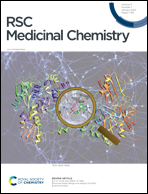用于治疗阿尔茨海默病的17β-HSD10抑制剂2-苯基- 1h -苯并咪唑衍生物的设计与合成
IF 3.597
Q2 Pharmacology, Toxicology and Pharmaceutics
引用次数: 0
摘要
据报道,17β-HSD10在阿尔茨海默病中起着关键作用。本文基于合理设计和SAR研究,设计合成了44个2-苯基- 1h -苯并[d]咪唑衍生物作为新型17β-HSD10抑制剂。其中,化合物33 (N-(4-(1,4,6-三甲基- 1h -苯并[d]咪唑-2-基)苯基)环己anecarboxamide)具有较高的抑制效果(17β-HSD10 IC50 = 1.65±0.55 μM),毒性较低(HepaRG IC50 = 1.65±0.55 μM)。Morris水迷宫实验表明,化合物33可减轻东莨菪碱所致小鼠认知功能障碍。这项研究有助于进一步开发更有效的17β-HSD10抑制剂来治疗阿尔茨海默病。本文章由计算机程序翻译,如有差异,请以英文原文为准。
![Design and synthesis of 2-phenyl-1H-benzo[d]imidazole derivatives as 17β-HSD10 inhibitors for the treatment of Alzheimer's disease†](https://img.booksci.cn/booksciimg/2025-2/102304797971781633177.jpg)
Design and synthesis of 2-phenyl-1H-benzo[d]imidazole derivatives as 17β-HSD10 inhibitors for the treatment of Alzheimer's disease†
It has been reported that 17β-HSD10 plays a key role in Alzheimer's disease. Here, a total of 44 2-phenyl-1H-benzo[d]imidazole derivatives were designed and synthesized as novel 17β-HSD10 inhibitors based on rational design and SAR studies. Among them, compound 33 (N-(4-(1,4,6-trimethyl-1H-benzo[d] imidazol-2-yl)phenyl)cyclohexanecarboxamide) showed high inhibitory efficacy (17β-HSD10 IC50 = 1.65 ± 0.55 μM) and low toxicity (HepaRG IC50 >100 μM). The Morris water maze experiment revealed that compound 33 could alleviate cognitive impairment induced by scopolamine in mice. This study facilitates the further development of more potent 17β-HSD10 inhibitors for the treatment of Alzheimer's disease.
求助全文
通过发布文献求助,成功后即可免费获取论文全文。
去求助
来源期刊

MedChemComm
BIOCHEMISTRY & MOLECULAR BIOLOGY-CHEMISTRY, MEDICINAL
CiteScore
4.70
自引率
0.00%
发文量
0
审稿时长
2.2 months
期刊介绍:
Research and review articles in medicinal chemistry and related drug discovery science; the official journal of the European Federation for Medicinal Chemistry.
In 2020, MedChemComm will change its name to RSC Medicinal Chemistry. Issue 12, 2019 will be the last issue as MedChemComm.
 求助内容:
求助内容: 应助结果提醒方式:
应助结果提醒方式:


